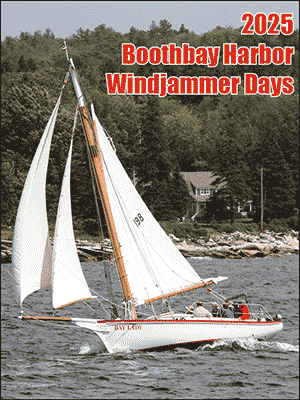Midcoast School of Technology takes new building proposal on road, talks to Lincolnville tonight
LINCOLNVILLE — Midcoast School of Technology Director Beth Fisher and the school’s hired architect is in the process of visiting 19 municipalities, presenting the idea of building a new $25.5 million vocational school on Rockland waterfront land.
The site is home to the existing school, which educates high school students enrolled in technology classes from across Region 8. The career and technical educational district crosses county lines and comprises much of the Midcoast and several larger islands. Last year, the cooperative board overseeing the school agreed to pursue constructing a new school to replace its tired building — an old shipbuilding facility acquired in 1975 to become a vocational school.
Fisher and Ron Lamarre, who represents Lavallee Brensinger Architects, have so far visited six towns, and this evening will be talking with Lincolnville Selectmen at their regularly scheduled bimonthly meeting. That meeting begins at 6 p.m. at the Lincolnville Town Office.
On March 15, Fisher and Lamarre presented their initial plans to Camden Select Board. They have scheduled 12 meetings in all, and either visit Vinalhaven, North Haven and Islesboro, or Skype a meeting with them.
The proposed plans call for replacing the existing 57,000-square-foot school with a new 90,000-square-foot building. The new school would sit closer to the waterfront on the parcel, which is assessed at $750,000.
Earlier this year, the Region 8 Board signed a new $65,000 contract with Lavallee Bresinger, the Cambridge, Mass., Portland, and Manchester, N.H.-based company, to conceptualize the building. Two years ago, the board had entered its first contract with the architects, paying them $80,000 assess the existing building and school programs. Read the Report here: Midcoast School of Technology, Education with a limitless view.
After concluding that the existing school building needed replacement, as opposed to renovation, the board’s planning subcommittee went parcel hunting. Since last year, Fisher said the subcommittee had evaluated 200 parcels in the Midcoast as possible new school locations, and ultimately returned to the Main Street, Rockland, land.
They all had “attributes and drawbacks,” Fisher told the Camden board.
The existing parcel is zoned for industrial use, but the City of Rockland voted years ago to allow for education use there. While its use is restricted, given the waterfront setback, it already has established utilities, a cost effective bonus for the entire project, said Fisher.
Region 8, Midcoast School of Technology
MCST’s building is a former Maine Shipbuilding facility that was acquired in 1975 following a public vote in regional towns approving the creation of Region 8 Vocational School.
That was when the state of Maine created its vocational schools, which are now referred to as Career and Technical Education centers (CTEs).
There are 27 CTEs in Maine with the purpose of providing technical skills that prepare students “for post-secondary education and entry into an ever-changing workplace and society and meet the rigorous academic standards of Maine's Learning Results,” according to the Maine Administrators of Career and Technical Education, the nonprofit that ties together the schools in Maine.
There are approximately 7,800 Maine students taking CTE classes in regions and centers. Taxpayers fund their respective portions of supporting MSCT through their annual education spending approved at June town meeting.
Other CTE funding derives from state education funding and federal grants.
In the Midcoast, six area high schools send students to, or participate with, the Rockland Region 8 campus for CTE.
Those students come from Islesboro; Oceanside, in Rockland; North Haven; Vinalhaven; Medomak, in Waldoboro; and Camden Hills Regional High School in Rockport.
In total, 19 municipalities are represented at MCST.
In 1975, the taxpayers approved spending $1.5 million to acquire the Rockport shipbuilding facility and renovate it for a vocational school.
Classes now include auto tech, auto collision, CNA medical science, design and marine technology, carpentry, small engine, welding, machine shop, hospital culinary, engineering, firefighting and emergency medical technician.
The Region 8 Midcoast School of Technology board consists of representatives of Islesboro, Monhegan, North Haven, Vinalhaven, RSUs 13, 40 and 65 (Matinicus), and the Five Town CSD.
Architect Lamarre said his company has designed several technology high schools in Maine, including one in Wells and Sanford.
Camden Select Board member Jim Heard asked Lamarre if the design would incorporate solar and other alternative energy.
Lemarre said that would be likely so, and referenced geothermal energy using nearby seawater, as well as solar panels on the roof. He also mentioned wind energy.
“None of these things have been decided on, just some we have set the table with,” said Lemarre.
Camden Select Board member Leonard Lookner asked if alternative energy classes would be incorporated into the school’s curriculum.
Fisher responded that the Maine Department of Education stipulated programs, but that Region 8 would be talking with the public about: “what programs we need to add or drop to fit the needs of the community. Green energy could be one of them.”
Both Fisher and Lemarre said that hard costs of the school, and the financial responsibilities of each municipality, had yet to be determined.
Lemarre said the $25.5 million price tag is in part built on the DOE’s formula that each square foot of new building construction amounts to $285.
“We believe we can do it less than that,” he told the Camden board, given no need for site acquisition.
In February 2015, he estimated for the Region 8 board that building anew would cost $200-$220 per square foot, without soft costs.
As for building design, he said his firm would bring a “technical aesthetic” to the construction.
Metal and durable materials would be featured, he said, likening it to the campus center at Manchester Community College, in Manchester, N.H., and which his company had designed.
The process involves completing the design by the end of Summer 2016, and presenting to voters in the 19 communities this coming November.
Then, it will take a year for engineering.
The best case scenario, Lemarre said, is to begin construction in Spring 2017.
Camden’s Select Board asked whether the tax impact for each town had been estimated.
“Not yet,” said Lemarre. “We can do that.”
Editorial Director Lynda Clancy can be reached at lyndaclancy@penbaypilot.com; 706-6657
Event Date
Address
United States




























